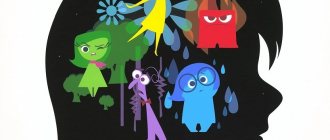Characteristics of perception as a cognitive process. Types of perception.
Perception (perception, from Latin perceptio) is a cognitive process that forms a subjective picture of the world. This is a mental process consisting of the reflection of an object or phenomenon as a whole with its direct impact on the receptor surfaces of the sense organs. Perception is one of the biological mental functions that determine the complex process of receiving and transforming information received through the senses, forming a subjective holistic image of an object that affects analyzers through a set of sensations initiated by this object. As a form of sensory reflection of an object, perception includes the detection of the object as a whole, the discrimination of individual features in the object, the identification of informative content in it that is adequate to the purpose of the action, and the formation of a sensory image.
Basic types and properties of perception. Perception as a direct reflection of the world is classified on various grounds. Traditionally, five types of perception are distinguished in accordance with the leading analyzer involved in the construction of a perceptual image - visual, auditory, tactile (tactile), gustatory, olfactory (classification according to the modality of perception). There are also types of perception depending on the object of perception, for example, perception of space, time, movement, speed; works of painting, music; the main phenomena of a person’s social life (another person, events in social life), etc. The perception of the surrounding world is usually complex; it is the result of the joint activity of various sense organs. Moreover, the perception of complex phenomena of the objective and social world is carried out primarily through the participation of the processes of memory, thinking and imagination. In other words, in many cases it is unlawful to talk about the process of perception in its “pure form”. In psychology, there is a division of types of perception depending on the participation of other psychological formations in it: emotional perception (perception of the world, art); rational perception (perception subordinate to the thinking process), etc. Each type of perception has its own specific features and mechanisms. Their description represents the task of both psychology and other branches of knowledge: physiology, cybernetics.
Sensory-perceptual processes “Types of perception”
Perception is the mental process of reflecting objects and phenomena of reality in the totality of their various properties and parts, associated with an understanding of the integrity of what is reflected. The result of perception is always an image of an object. Without picking up an object, we not only see it, but also feel its weight, volume, if it is metal, its coldness. All these sensations are generalized into a single image of a given object. In the formation of the perception of an object, the elements of which are sensations arising from various properties of this object, memory and thinking are also of great importance.
Basic qualities of perception
Apperception is the dependence of perception on the past of an object. People of different professions can perceive the same objects or words differently.
Meaningfulness and generality . Perception is not only a sensory image, but also awareness of a selected object. This is achieved by understanding the essence of the subject.
Integrity. The individual elements of an object are combined into a single whole.
Constancy is the relative constancy of the perceived size, color, shape when changing perspective and illumination.
Selectivity is the preferential selection of some objects over others.
Objectivity. Objects may be the same (similar) to the touch, but we define them not by their appearance, but in accordance with how we use them in practice or by their basic properties.
Perception does not always give an absolutely correct idea of objects in the surrounding world. There are known facts of distortion of reflection during perception; they are called illusions of perception. Perceptual illusions can occur in different modalities. The greatest number of them is observed in the field of vision. Visual illusions (optical illusions) are errors of perception that arise when reflecting certain spatial properties of objects (lengths of segments, sizes of objects and angles, distances between objects, shape) and movement. Illusions in the field of vision are extremely numerous and varied.
Illusions can be observed not only in the field of vision, but also in other areas of perception. Thus, the illusion of gravity by A. Charpentier is well known. This illusion lies in the fact that if you lift two objects of equal weight, in appearance, but different in volume, then the smaller of these objects is perceived by a person as heavier and, conversely, an object of larger volume is perceived as lighter. The basis of this illusion is the connection formed in life between weight (volume) and the size of objects: the greater the size, the greater the weight. And when this expectation does not correspond to reality, a contrasting illusion arises.
In the field of touch, Aristotle's illusion is known. If we interlace two fingers—the index and middle ones—and with these crossed fingers begin to simultaneously touch a ball or pea (roll them), then we will perceive not one ball, but two. In addition to illusions that are the result of the influence of features inherent in objects perceived at the moment, one can observe illusions that arise under the influence of immediately preceding perceptions. Such, for example, are the contrasting illusions observed when developing an “attitude” using the Uznadze method. These illusions consist in the fact that after repeated perception of very different objects (in weight, size, volume, etc.), objects that are equal in the same respect are perceived by a person as unequal: an object located in the place of a previously perceived smaller object seems larger, and etc.
Types of perception
The perception of time is a reflection of the objective duration, speed and sequence of phenomena of reality. The perception of time is based on the rhythmic change of excitation and inhibition in the cerebral hemispheres. Various analyzers are involved in the perception of time; The most accurate differentiation of time intervals is provided by kinesthetic and auditory sensations. THEM. Sechenov called hearing a time meter, and auditory memory the memory of time. The subjective perception of long periods of time is largely determined by the nature of the experiences with which they were filled and the emotional state of the subject.
The perception of space is a sensory-visual reflection of the spatial properties of things (their size and shape), their spatial relationships (location relative to each other and the perceiving subject both in plane and in depth) and movements. All human senses are involved in the perception of space. The leading role in the perception of space belongs to the joint activity of the visual, motor, cutaneous and vestibular analyzers. The greatest information about space (up to 95%) is given to a person by vision.
The perception of complex sounds is the process of receiving and processing by an auditory analyzer sounds of a complex spectral composition, usually changing over time according to an algorithm characteristic of a given source. The world of complex sounds is extremely diverse, but some groups with relatively common characteristics and principles of perception can be distinguished in it. These groups include: sounds of a synthetic environment (technical objects), voice sounds and speech sounds, musical sounds.
Perception of oral speech is one of the highest mental functions of a person. The perception of oral speech is the internal mental side of such a type of speech activity as listening (listening).
Speech perception is a heterogeneous process. In this process, levels of discrimination and recognition can be distinguished from a genetic and functional point of view. From the point of view of the nature of “processing” of the speech signal, sensory, perceptual and semantic levels of perception are distinguished, so in the process of perceiving an oral speech message at the sensory level, acoustic analysis and selection of sounds in the word, which is recognized at the perceptual level of perception, is carried out. At the semantic level, the meaning of the sentence and the entire message as a whole is established.
The perception of a person by a person is the process of psychological cognition by people of each other in conditions of direct communication. This process includes all levels of mental reflection, from sensation to thinking. In this sense, the process of human perception by a person is subject to the general laws of mental reflection, despite the originality of the object of perception, which is determined by its special social significance among other objects of the world around a person. The special social significance of a person as an object of perception puts him in first place in the process of recognition among other objects. When perceiving a new person, the subject pays the main attention to such features of appearance that are the most informative regarding the mental properties of the individual - facial expression and expressive body movements. The dominant elements of the human face as a complex stimulus are hair (hairstyle) and eyes.
In the process of perceiving a person by a person, people’s ideas about each other, the ability to determine character traits, abilities, interests, emotional and dynamic characteristics, people’s professions, etc. are formed. The first place among these features is occupied by the professional characteristics of the individual as the most significant in social terms. Awareness of a professional characteristic forms a more stable attitude towards a person compared to the first impression, which is formed on the basis of assessing the attractiveness of appearance.
Imagination
Imagination is understood as a cognitive process in which objects and phenomena at a given moment in time are not perceived by the senses, but are formed on the basis of the experience gained. Imagination is closely related to memory and is characteristic only of humans. It can affect body function and movement.
They distinguish involuntary imagination, i.e. the formation of images without any human effort, and voluntary imagination, in which an individual deliberately tries to imagine something specific. Dreams are a special type of imagination. A dream is a conscious process of creating images of what is desired; they show what is important to a person and what he strives for.
Intelligence
There are a huge number of approaches to defining the concept of “intelligence”.
For most psychologists, this concept is currently associated with the ability to learn from past experience and adapt to life conditions and situations.
For some, intelligence is equivalent to a person's overall giftedness and is the sum of their overall mental abilities.
An original approach to understanding intelligence was proposed by B. G. Ananyev. He viewed intelligence as a multi-level organization of cognitive forces, covering the psychophysiological processes of the state and properties of the individual. This organization is associated “with the neurodynamic, autonomic and metabolic characteristics of a person. They are unique equivalents of intelligence and determine the measure of mental performance and the price of intellectual stress, the degree of their usefulness and harm to human health...”
Intelligence tests are usually used to assess the level of intelligence development. The most common are the Stanford-Binet and Wechsler tests.
The attitude of psychologists towards assessing intelligence using tests has not been fully determined.
Speech and language
The emergence and development of language marks the emergence of a new special form of reflecting reality and managing it. With the help of language, abstract thinking is carried out (that is, going beyond the immediate reflection of reality), the accumulation and transfer of experience, knowledge, and skills occurs. Language is the most important tool for interaction between people and one of the most important means of development of the human psyche.
Language is a complex system of codes that was formed in social history. The main element of language is the word. The word is a means of encoding human experience (denotes things, highlights signs, actions, relationships).
0
1.5










